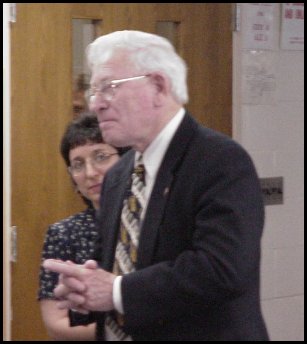


Mrs. Vaianella and Mr. Oser
| “Laurie, do you want to sign up for the
class Susan is giving so we can learn that new program?” I asked my
colleague. We’d just had Inspiration software loaded and really
wanted to give our students every opportunity to use it.
As we sat together exploring the program, we wondered aloud how we could make our Social Studies curriculum a little more interesting for our students. Susan came to check on our progress, heard our comments, and asked if we knew anything about the program that placed homeless children from New York City into Midwestern homes. “Do you mean the Orphan Train?” I asked. Suddenly we had a new direction. The three of us started surfing the Internet for any information we could find on the Orphan Train. Of course, Susan was the master surfer, followed closely by Laurie, who have both taught this “newbie” quite a few tricks. We found written material and photographs that we could integrate into DBQs. We found the official web site of the Orphan Train Heritage Society, and we found recently written trade books that we could use as read alouds. Laurie and I hunted our local libraries and came up with an armload of books we could use with our classes. Each morning, we shared facts and information we’d learned from our nightly reading. The more we read, the more excited we became. Meanwhile, Susan contacted as many online sources as she could seeking permission for us to use copyrighted images and documents for our project. She excitedly told us of hearing from Renee Krantzer, MU College of Education/MOREnet liaison who wanted to have a videoconference between our fourth grade students and Janice Uptegrove's fourth grade in Smithville, Missouri. Each time she reported back to us she had more exciting news. Renee was able to locate the daughter of Irma Craig, an orphan train rider who was willing to share her mother’s story with the children. The students in Smithville were reading Joan Lowery Nixon's A Family Apart, which is a fictional account of one family’s story. Both Laurie and I had begun to read copies of the book and wanted to share it with our students. I spent one rainy weekend on the couch reading We Rode the Orphan Train, which contains interviews with actual orphan train survivors, one of whom lives on Long Island. His story is unusual because Bill and his sister were removed from the home where they’d been placed and returned to New York where the lived in orphanages. Having him present his story as a contrast to that of Mrs. Andrews would be a wonderful opportunity for our students. I wondered if I could contact him. With the help of the Orphan Train Heritage Society, I got Bill Oser’s address in Queens, and after a quick call to information, I had his phone number. I have to admit I was a little nervous about calling him. How would this senior citizen handle a call from a school teacher 80 miles away asking him to talk to a group of children both live and via video equipment? First I left a message on his answering machine. A few days later, on a Sunday afternoon, I called again. Mrs. Oser answered the phone. “Yes, dear, he received your message. He’s at church right now but he planned on calling you later this afternoon. You’ve called twice now, dear, so don’t call back again. Bill will call you.” Feeling chastised I thanked her and awaited her husband’s call. Late that night, after my husband and I had spent the day entertaining guests, the phone rang. I was elbow deep in dirty pots, so my husband answered the phone. “Oohh, Bill Oser! Your name is on my refrigerator!” I heard my husband tell him. Inwardly I groaned. Sometimes my husband can be really silly, and I was afraid his sense of humor would not be appreciated. I didn’t need to worry because Charlie and Bill were on the phone for 15 to 20 minutes before he would finally hand it over to me. Bill complimented me on choosing a husband who knows how to laugh, and then proceeded to make me laugh so hard my sides ached. As it turns out, Bill is an old-fashioned charmer! And he was thrilled for the invitation and would be happy to drive out to Port Jefferson Station to talk to the students. We talked on the phone on several different occasions to set up our plans, each time Bill made me laugh, but we also shared some very serious moments. Bill has taught me to appreciate my family in ways I hadn't thought of. You see, he grew up without any parents or family except his sister, from whom he was separated at a young age. I wasn’t sure he’d want to spend the whole day with us, but Bill was fascinated with the idea of the technology. He sent a videotape that he’d made to share with the children. It included background information on the orphan train, clips from “Unsolved Mysteries,” and video from Orphan Train Historical Society reunions. His hard work was a touching tribute. Luckily the day of the videoconference was sunny and dry. Bill would have perfect driving weather! He greeted me as if we’d known each other for a long time, with a warm embrace and firm kiss on the cheek. As he got involved in the videoconference, he began to share his story with the students in NY and MO. He was relaxed and natural and easy going. The children were fascinated with all he had to say and responded respectfully. They even asked him for his autograph! The videoconference was a phenomenal success, thanks to Susan Silverman, Renee Krantzer, Gary Lamm and John Worobey, and a marvelous culmination of our Orphan Train project. And to think, we just wanted to make Social Studies more interesting! Linda
Vaianella |